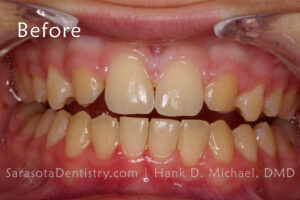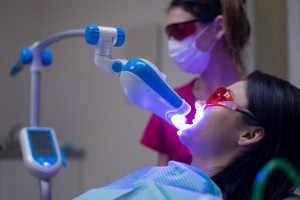Few people can maintain their original teeth whiteness without some form of treatment or intervention. Most individuals experience tooth discoloration over the years. The accumulation of some stains and yellowing is generally inevitable.
Many safe teeth whitening options exist. While some over-the-counter treatments can be less expensive, they are usually not as effective or as comfortable as what you get at the dentist’s office. Understanding the causes of tooth discoloration and the costs associated with teeth whitening can help you decide how to treat your discoloration.
Table of Contents
- Causes of Tooth Discoloration
- Professional Teeth Whitening Cost
- Benefits of Teeth Whitening at the Dentist
Causes of Tooth Discoloration

There are three types of teeth staining, one of which is extrinsic, which primarily affects the enamel or surface of the tooth. Coffee, dark sodas and teas, red wine, and dark fruits can leave stains on tooth enamel, but they tend to be easier to remove.
People can also develop intrinsic staining, which occurs inside the tooth. Intrinsic discoloration typically results in a grayish appearance, and it is usually impervious to over-the-counter (OTC) whitening products. This discoloration can come from tooth decay, certain medications like antibiotics, consuming too much fluoride, or injury to the tooth. Also, some people are genetically predisposed to intrinsic staining.
Finally, tooth discoloration usually happens as we age. The older we get, the more the enamel wears away, showing more of the dentin, which is the inner, softer part of the tooth. This dentin exposure creates a yellow look.
Professional Teeth Whitening Cost
Teeth whitening solutions vary significantly by cost, delivery method, and results. At the most basic level, you can purchase mouthwash and toothpaste that offer whitening benefits. Such products cost $5-15 dollars, contain minimal amounts of peroxide, and pose a relatively low risk for people with sensitive teeth and gums. However, whitening toothpaste and mouthwash might not yield the long-term effect you desire.
You might also consider whitening strips, another type of OTC remedy. A package of strips can cost $30-100 and contain 5-15% peroxide. Simply place the strips over your bottom and top teeth and remove them after about 30 minutes. While they can yield noticeable results, some people are sensitive to the strips, which can be challenging to keep in place.
Other patients opt for LED kits, which you only need to use a few times a month. They cost between $50 and $300, and they offer the non-invasive use of LED light to remove more persistent stains. However, while LED kits provide relatively quick results, they can also cause moderate sensitivity in teeth. Also, scientific studies have found the LED light isn’t necessary.

Professional teeth whitening is also available for people who have stubborn stains or want quicker and longer-lasting results. Most professional procedures use more peroxide than at-home versions, which can cause temporary sensitivity. Dental whitening can cost $400-$1,000 but requires fewer treatments.
Many dentists offer KöR teeth whitening, a safer alternative to professional teeth bleaching and lasers, which can aggravate sensitive teeth and gums. KöR deals with discoloration by restoring oxygen in teeth. Also, unlike most tray-based gel treatments at the dentist, KöR contains peroxide that remains constantly refrigerated from shipment to application. Keeping the peroxide cool prevents it from deteriorating, making it a more effective teeth whitening treatment.
With KöR Whitening, there are four whitening plans the doctor will prescribe based on the type of stains present in the teeth. The basic plan is a KöR Home which is an at home system that can be used day (9% Hydrogen Peroxide) or night (16% Carbemide Peroxide). The next step us is KöR Max which adds an in-office application following the at home whitening (34% Hydremide Peroxide). Even more powerful is the KöR Ultra which adds an in-office treatment (13% Hydremide Peroxide) before at the at home application and another in-office application (34% Hydremide Peroxide) following the at home whitening. The final KöR system has been specially designed to treat deep tetracycline staining in the teeth. This is KöR Ultra-T which starts with in-office (13% Hydremide) followed by 6- weeks of at-home whitening and finalized with in-office treatment (34% Hydremide Peroxide). Each professional whitening treatment requires maintenance. Some will perform maintenance whitening one or twice a month some may do 1-5 treatments every 3 months. Others may perform maintenance teeth whitening once per week or once per year. Maintenance cycles vary greatly depending on the patients diet and teeth reactivity.
Benefits of Teeth Whitening at the Dentist
As previously mentioned, teeth whitening in the dentist’s office can aggravate tooth sensitivity in some patients. However, this effect is typically moderate and temporary. Also, professional whitening has advantages over OTC at-home treatments. In-office procedures are safe and cause virtually no damage to teeth and gums. Also, bleaching and other whitening options use carbamide peroxide or hydrogen peroxide to remove more difficult stains.
Another benefit of professional whitening is that it typically offers faster results. Most patients see enhanced whitening just one hour after their in-office treatment. In addition, the improved appearance lasts longer than OTC alternatives.
Also, OTC treatments are not customizable, meaning that they offer a one-size-fits-all approach. On the contrary, patients can receive professional whitening that fits their preferences and specific dental needs.
Professional teeth whitening benefits can be cost-prohibitive for some patients. Most dental insurance plans do not cover in-office teeth whitening and other types of cosmetic dentistry because they are not medically necessary procedures like root canals, cavity fillings, or crowns. However, patients wishing to pursue professional teeth whitening might ask their dentists about payment plans that can make whitening more affordable. Teeth whitening is by far the most affordable form of cosmetic dentistry and can render fabulous results if done correctly.
- Dental Implant Pros and Cons - August 26, 2023
- Receding Gums Stages - August 12, 2023
- When Is It Too Late for Gum Grafting? - July 8, 2023


